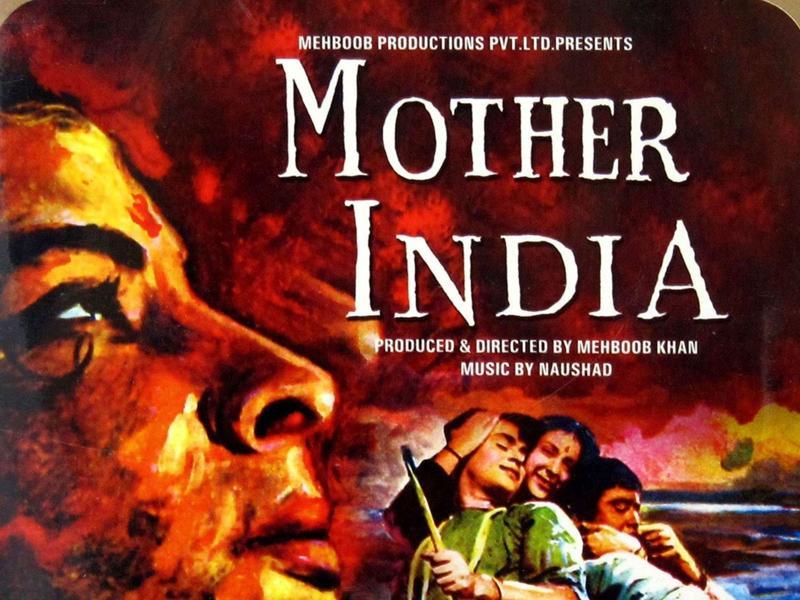Listen the Article:-

Story:
Mother India tells the tale of Radha, a destitute, illiterate villager who tries to provide for her family. It is set in rural India in the years leading up to India’s independence (1947).
In order to satisfy their excessive debt to the village moneylender Sukhi Lala, Radha’s husband Shyamu is compelled to pawn the gold bangles that come with her dowry (also known as the woman’s riches or stree dhan), their land, their cows, and their heirloom brassware.
Radha’s house is destroyed by floods, and two of her four children perish.
After Shyamu deserts her, Sukhi Lala sees an opportunity and offers Radha money in exchange for sexual favours.
Radha raises her two surviving children on her own because she won’t give up.
She is able to prevail where Shyamu fails because of her tremendous strength and willpower.
Due to Radha’s achievements, the hamlet refers to her as the mother, a label that later comes to represent the entire country, giving rise to the well-known moniker Mother India.
Analysis:
Mehboob’s own popular talkie Aurat (Woman, 1939) was remade as Mother India with The Good Earth as its primary inspiration (1937).
Mehboob established his own studio with a hammer and a sickle as its emblem thanks to Aurat’s popularity.
1
Mehboob’s usage of the hammer and sickle, though frequently interpreted as communist propaganda, is actually a powerful allusion to his humble beginnings as a farmer and his appreciation of the peasant way of life.
2
One of the first talkies to be set in rural India was Aurat.
Mehboob lifts Mother India to a national scale by drawing on the twin experiences of independence and partition, in contrast to Aurat, which is a gritty story of feminine agony and sacrifice that results in the death of a grieving mother.
This is clear not only from the title change, but also from other stylistic changes made feasible by the then-new Gevacolor technology.
3
Mehboob and his cameraman Faredoon Irani used synch sound to shoot on location in his native Gujarat, giving Bombay film a new level of heightened, stunning realism.
The updated version combined professionally staged studio pictures with actual flood video.
Mother India employs stunning rural celebration scenes and a striking use of red earth tones to create a magnificent family drama that takes place in an unusual location—a hamlet.
The opening sequence of the movie features Soviet-style shots of tractors working a lush, productive landscape against a backdrop of a recently built dam.
An elderly Radha, seen in extreme close-up, shakes her badly wrinkled, weathered face in amazement when asked to officially open the dam.
The tractor and dam would have been instantly recognised by modern audiences as compelling symbols of the Nehruvian ideal of socialist growth.
Radha’s horrific history floods back into her mind as the villagers press her to complete the renowned duty.
A flashback that shows a conflicting, untold story follows this provocative segue, which clearly establishes Radha as the point of view.
Then, Radha is shown as a youthful, incredibly attractive bride who selflessly sheds her bridal robes to dedicate herself to raising her family.
Only a portion of this story is told by the debt repayment.
In a horrible accident, Shyamu loses both of his arms along with his masculinity, turning him into just another mouth to feed.
Sukhi Lala constantly harasses Radha, and in a serious setback, her younger son Birju betrays her confidence by becoming a ganja (marijuana)-smoking criminal.
As if this weren’t bad enough, Birju kidnaps Rupa, the daughter of Sukhi Lala, from the altar of her wedding.
Despite the fact that Birju is motivated by a desire to get revenge for his mother’s cruelty, by doing so he jeopardises Radha’s hard acquired goodwill and izzat, a term that denotes virginity as well as respectability.
Radha begs Birju to give up Rupa and not jeopardise her izzat, which by this point includes the respectability and chastity of both women.
Also read:- https://republicaeon.com/2023-critics-choice-awards-naatu-wins-rrr-best-foreign-film-and-best-song/
Radha threatens to kill Birju when he declines, showing her increased devotion to the community.
Radha shoots her adored son once, spectacularly killing him in a startling and unheard-of action.
No other Indian movie has depicted motherhood in such a detailed way, showcasing Radha’s stunning beauty one minute and her heartbreaking loss the next.
Mother India 👏
What a masterpeice. One of the few flicks which came out of India and still continues to thrive! It's truly one of it's kind and for it's time. I can see why it's known as the great Indian movie of all time 🌟🌟🌟🌟🌟 pic.twitter.com/pBHLEaJTzx— Ameena 🌹🇵🇸 (@ameena_q90) April 28, 2022
It is an old school Indian movie, by Mehboob Khan, called "Mother India". Even though it has many of the oversimplifications and melodrama of late 1950s film making it still a compelling but painful full of truth of how it is for the poorest. Also the cinematography is gorgeous pic.twitter.com/xvw3SwsZui
— Jodi Gemini 🐀 (@dizzyborden1972) March 29, 2022



